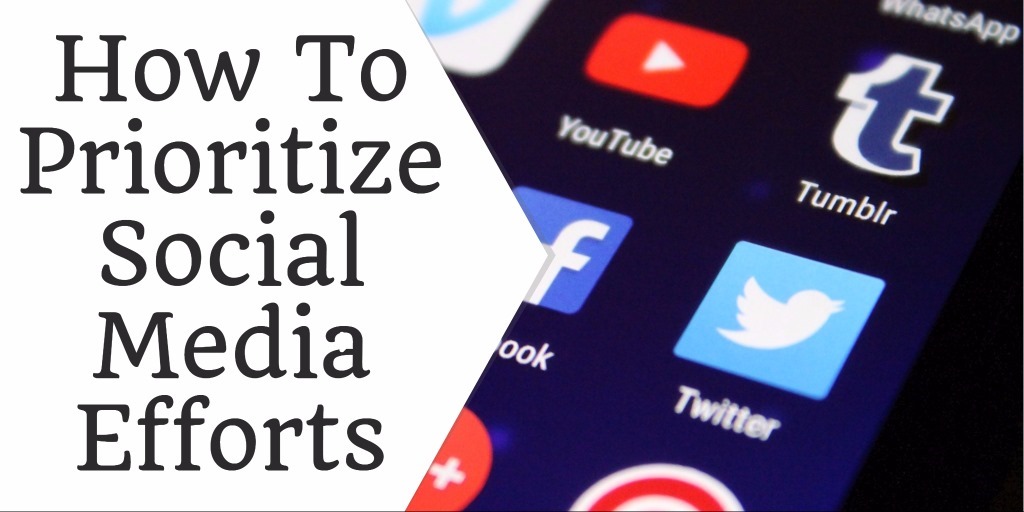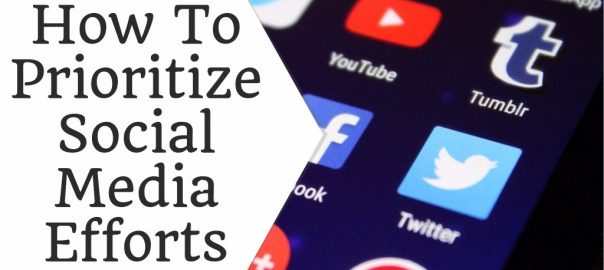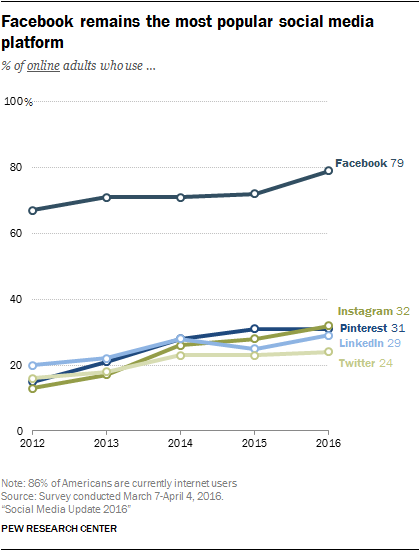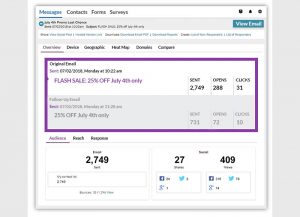
Gone are they days where marketers could afford to ignore the shiny new ball that is social media. It is no longer something that marketers should be experimenting with; it’s 2017, and using social platforms have become a bare minimum in the scope of a company’s larger marketing strategy.
But which ones are you active on?
Which ones should you be on?
What are the emerging platforms you need to be learning now?
These are the questions that plague marketers who struggle with prioritizing what they should be doing relative to their industry and overall marketing goals. And with hundreds (or even thousands) of social “gurus” popping up on what seems to be a daily occurrence, it’s incredibly difficult to pick out what should and shouldn’t be done in the realm of social media.
Too many marketers cast a wide net and don’t focus on the platforms relevant to their business, with FOMO (fear of missing out) causing an anxiety that if they don’t touch every platform that they’ll miss out on some big opportunity. The fact is that using social media is complicated and time-intensive; it requires serious thought and strategy to get it right.
The State Of Social Media In 2017
At year’s end, 2016 saw a handful of technical changes and features added to each platform, but there also changes amongst each platform’s growth.
Snapchat Blew Up, Instagram & Facebook Took Notice
Snapchat was the hot social platform as the image sharing and communication app is on the verge of an IPO and widespread adoption across multiple demographics. More noteworthy is that Snapchat continued to push public interest in augmented reality with its on-demand geo-filters and Instagram has
500
million monthly
active usersAR lenses. Not only that, but Snapchat became the only social entity to launch a physical product: Snap, Inc. Spectacles.
Facebook and Instagram were not oblivious to this considering Facebook has made a massive shift towards Facebook Live functionality. Instagram virtually copied what Snapchat could do after launching Instagram Stories and grew to 500 million monthly active users.
Facebook Remains King, Twitter Refocuses
Although Facebook doesn’t appeal to younger users as it once did, Facebook is still the king of social, boasting a user base of almost 72% of adult internet users. Facebook pushed out some new feature launches, but video continued to grow as the social platform is currently testing an ad revenue sharing system similar to YouTube and its community of content creators. So despite being the oldest, Facebook continues to be on top and seemingly adapting with the times.
2016 may not have been as kind to Twitter, but their team of execs, including CEO Jack Dorsey, have shifted focus and labeled Twitter as a news platform. This is in line with the ultimate benefit of Twitter since users can communicate and share information in real-time. User growth continues for Twitter, but not at the rate investors would have wanted.
Pinterest & LinkedIn Carry On
There were few changes regarding LinkedIn and Pinterest with few product updates rolling out in 2016. Communities involved with each platform continue to cement as both had relatively little growth in active users. LinkedIn did make several product updates that helped improve the overall user experience, and popularity rose in 2016.
Social Networks Compared #Stats
To understand where each platform stands in relative popularity with one another (excluding Snapchat), here’s a ranking from a recent Pew Research study conducted in August 2016:
The Road To Mastering Social: Understanding Your Goals
Understanding your goals may seem overly obvious, but it’s surprising how often this step is neglected. If a marketer’s approach to using social media for business does not identify which goals you are trying to accomplish, the odds of achieving these goals will, in turn, be very low without the appropriate focus.
Start by thinking about what overall goals you have for your business so you can tailor your strategy in a way that social media can help you achieve those goals. Make sure that your goals are realistic and specific so as not to set yourself up for failure. They must also ultimately align with overall sales, marketing, and productivity goals.
Having An Honest Understanding Of Your Brand
When there is a deep understanding of your brand and followers on social can quickly grasp and communicate the values of your brand to others, this is a critical step when considering how to leverage a particular platform.
But your idea of your brand and having an accurate perception of what it is can sometimes be at odds with one another. For example, your team may be creating the best content on Snapchat in your industry, but that doesn’t mean your ideal customer or lead is spending their time on there.
This also means understanding what you and your internal team can achieve from a capacity standpoint. Video may not be your strong suit, but creating in-depth, informational blog posts could be your bread and butter.
Once you have this honest understanding of your brand, this will ultimately shape the content you will create and share, the type of people you want to reach, and what platforms you’ll target.
How To Map Multiple Client/Customer Personas
There are a ton of great resources out there on creating customer personas, but the basics are as follows:
- Personas create the ideal customer, and shape how you want to reach that customer
- Your business may not have one type of persona that finds value from your offerings; you probably have multiple personas that can be created
The idea behind using social media marketing is the same reason why television used to be the end-all-be-all advertising platform. Marketing is all about reaching your ideal customer in the places where they are spending their time and attention. So in television’s heyday, consumers were devoting their attention to this brand new, visually engaging medium.
So for personas, try to create multiple, fictional characters that represent subcategories of customers and client looking for your products or services. You can then use this persona to create your social content strategy and fit that strategy to each platform.
Understanding The Differences Between Social Platforms
As you’ve probably surmised by now, every platform is unique in its own way, and it can be hard to understand the nuances between them unless you devote considerable time. You could read lengthy books, like Gary Vaynerchuk’s Jab Jab Jab Right Hook, or scour the web for tons of online resources that offer conflicting information.
Or you could check out this little cheat sheet which breaks down all of the current social platforms.
Regarding social media, Facebook is almost like the center of the universe. It remains to be the largest platform the world over, so using Facebook is casting the widest net possible. With constant changes to its Newsfeed algorithm, organic posting will continue to be a challenge.
If you can, figure out how your brand can regularly post video content since Facebook is continuing to grow its video platform. And if you have a YouTube channel and are posting there regularly, consider posting video native to Facebook as opposed to sharing YouTube links.
The darling of social media marketers may have lost some of its pizzazz compared to a few years ago, but this is still a powerful tool for promoting your content. It’s generally OK to fill up your queue with your own and curated 3rd party content, but don’t rely on this too heavily.
The underrated beauty of Twitter is the direct line to other users, so here’s a challenge for 2017: be social! Get out there and engage with more folks.
Instagram & Snapchat
Despite what you may think, Instagram and Snapchat have more in common than you may think. The reason why Instagram even has a story feature is to reclaim potentially lost users who may like Snapchat’s similar feature. They’re both image driven platforms, so a lot of what you’re posting will look very similar. The only difference is that Snapchat is slightly closed off with a personal connection, whereas Instagram activity is more public.
Unfortunately, if you’re in an industry where it’s hard to come by good looking, captivating imagery or video, both platforms may not be for you. If there is one advantage of using Snapchat, it’s that 1-to-1 communication is much easier and widely accepted because of the private nature of the platform.
The biggest thing to think about when approaching Pinterest is that it’s probably the platform most associated with the future than any of the others. When you try to categorize the most popular types of content being shared and viewed on Pinterest, you’ve probably noticed they all relate to things that users want to do at some point in the future. Whether it’s browsing recipes, looking at wedding decor ideas, haircut styles, or even viewing products themselves, Pinterest users are saving their favorite pins to look at later.
For B2B brands, this may not be your cup of tea since this is still a visually centered platform and best for publishers and retailers. Not mention that the user base remains to be primarily female and slightly more niche than the other social platforms.
Reddit, Tumblr & Imgur
When it comes to appealing to niche audiences and communities, these three can be a gold mine for reaching those potential customers in a unique way. For example, if you’re a woodworking ecommerce retailer, the/r/woodworking subreddit is one of the most active communities on Reddit, and you could figure out how to share your content that they would enjoy.
This can even work for B2B marketers, but some communities will have larger pools and active members depending on the subject matter.
Organic Posting Vs. Promoted Posts
If you’ve spent any time using Facebook for social media marketing, you’ll probably notice that your posts are only being seen by a small percentage of your audience. Same goes for Twitter, and this is because social media has become a noisy environment for sharing content. It’s free to post organically, and everyone has been doing for some time.
The fact is that every platform earns revenue from ad dollars, and subsequently, each social platform has developed complex and effective advertising solutions. Facebook is again the king with the most advanced advertising solutions and the ability to advertise on Instagram. From there, each platform has unique benefits for using them, but organic social media is becoming increasingly difficult.
Especially on Facebook, you need to figure the balance between posting organically and when it would be beneficial to using social ads.
Auditing Internal Content Creation Capacity
The final step in mastering social media is understanding your internal capacity to create, curate, and post content to your social platforms of choice. This ties back into understanding what your creative does best and focus on improving those areas.
Blog Posts
Blogging has been around since the dawn of the internet, and it is still a reliable way to attract readers to your site via search, email, and social media. If your company blog isn’t being updated on a quasi-regular basis, think about how you can get back on schedule and what team members can help maintain consistency.
But as many content marketers will tell you, publishing a blog post is never the last step in the content creation process. Social media is where you need to promote your content and multiple times. For blog pieces that took considerable time to write and create, you may want to consider using social advertising to promote these pieces.
Video & Photography
Despite what you may think, but taking high-quality photos and videos are becoming much easier as smartphone technology continues to improve. At a minimum, most platforms do well with engaging photography, and video is slowly shaping up to become the future of content on social media. Try to incorporate more imagery in your content approach, but you may also want to invest in hiring a videographer to build up a bank of video content to share.
Live Streaing
Despite Facebook making a hard push for its Facebook Live feature, 2016 was a questionable year for other live streaming platforms. The jury’s still out on whether or not Facebook Live is an effective marketing tool for everyone, but keep this on the back of your mind. Now is the time to learn and experiment, but don’t dive in face first.
Which Social Channels Should You Target?
The hardest question to answer is where you should be spending your time. Instead of s shotgun approach, try figuring out which channels lend themselves to the most engagement. LinkedIn may be the best place for B2B brands, but maybe you have found the most success with your Facebook followers.
Prioritize social channels like this:
+Time & Resources to Create Content
+Time to Engage
+ Channels with Highest Engagement
If you can get more results from focusing on one or two platforms rather than lightly touching multiple platforms, spend all your time and energy on getting those platforms right.
It all comes down to understanding what your brand is about, the quality of content you can produce, and a deep understanding of your ideal customer and how they use social media. Once you have all those pieces, social media should make a lot more sense in 2017.
* Adapted lead image: Public Domain, pixabay.com via getstencil.com
How To Prioritize Social Media Efforts
The post How To Prioritize Social Media Efforts appeared first on Search Engine People Blog.
(70)









